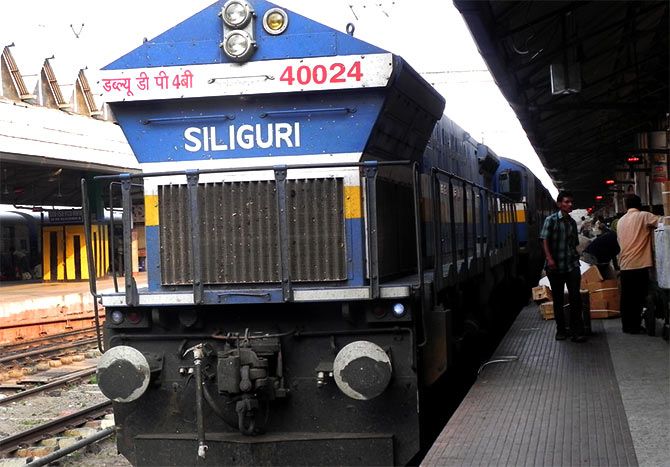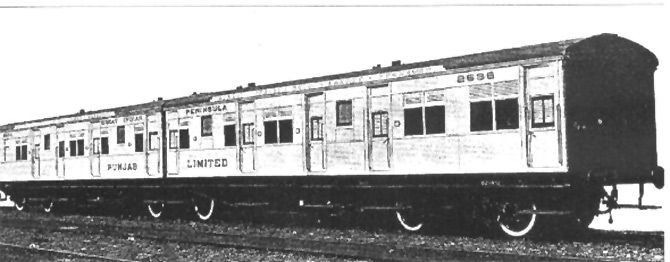 | « Back to article | Print this article |

Trains, at one point in time, were not just a mode of transport. They told a story, says Bibek Debroy.

This is a good quiz question. Which train has the number 12345? The answer is the Saraighat Express, from Howrah to Guwahati. The train is named after the Battle of Saraighat (1671) fought between the Mughals and Ahom rulers.
Such is the state of history taught in textbooks that most people don't know the Ahom kingdom lasted from 1228 to 1826, much longer than the Mughal empire's 1526 to 1857.
In 12345, 1 tells us it is a long-distance train, 2 tells us it is a super-fast train, 3 tells us the train/rake belongs to Eastern Railways and 4 tells us (I think) the train/rake belongs to Malda Division. I don't know about 5.
These days, notwithstanding the Rajdhani, the Shatabdi and even the Gatimaan, trains have been reduced to numbers. In a different day and age, that wasn't the case. Trains also possessed names and some of the famous ones were iconic.
The first such train was clearly the Punjab Mail, introduced between Ballard Pier (later moved to Victoria Terminus) and Peshawar (later moved to Firozpur) by the Great Indian Peninsula Railway in 1912.
On some days, this had mail connections with P&O steamships. Indeed, that's how the Punjab Mail originally started. In those days, it operated as Punjab Limited and operated from Ballard Pier (Mole Station) to Peshawar. Today, we would call it multi-modal. This was a distance of almost 2,500 km in 47 hours, a very respectable speed of 53 km/hour.

When it started to run daily, Punjab Limited became the Punjab Mail and, for a very long time, was the fastest train in India. In the initial years, it was an extremely prestigious train and first class restriction gave it exclusivity.
The Punjab Mail was adulterated with third class carriages in 1930s, second class and servants having been permitted earlier. Later, it was overshadowed by the Frontier Mail.
There used to be a Mumbai-Peshawar Mail and the Bombay Baroda and Central India Railway replaced it with the Frontier Mail in 1928. During winter months, from September to December, the Frontier Mail connected with P&O steamships and, therefore, started from Ballard Pier (Mole Station). Consequently, BBCI used Bombay Port Railway tracks and also those of GIPR, before it moved on to BBCI tracks.
In non-winter months, the train ended at Colaba (south Mumbai).
GIPR and BBCI competed over several things, such as which company would cross the Western Ghats first. They also competed over the Mumbai-Peshawar route and once it was started, the Frontier Mail overtook the Punjab Mail. It was faster and more elitist.
The Frontier Mail was known for its punctuality. It was said that a Rolex watch might let you down, but not the Frontier Mail.
In August 1929, there was an instance when the train was 15 minutes late and this created an uproar, the driver being asked to explain the reason for this 'inexcusable' delay.
The following interesting story seems to have been first pieced together by Rosie Thomas.
 In 1936, Wadia Movietone decided to produce an action crime thriller directed by Homi Wadia. This starred Fearless Nadia (Mary Ann Evans) and the setting for the murder mystery was a railway station.
In 1936, Wadia Movietone decided to produce an action crime thriller directed by Homi Wadia. This starred Fearless Nadia (Mary Ann Evans) and the setting for the murder mystery was a railway station.
Unfortunately, the film was titled Frontier Mail. BBCI objected, since the film showed a crashing train, that too after the film company had been allowed to film on BBCI trains and tracks.
About a month before the film's release in May 1936, angry BBCI officials contacted J B H Wadia and objected. There were graphic posters of the film, with the image of a train crashing and the blurb, 'By kind permission of the BB & CI Railway Company.'
Wadia agreed to change the name and did what would today be called crowd-sourcing. Through newspaper campaigns, he asked people to write in, suggesting names. The name, thus, agreed to was Miss Frontier Mail and the publicity booklet stated, 'We hereby inform the public that our Rail-Road Thriller, Miss Frontier Mail, has no connections whatsoever with the well-known 'Frontier Mail' of the B B & C I Railway. It refers to the name of the heroine of the story and not to any train whatsoever in India.'
The iconic Frontier Mail now has the name Golden Temple Mail.
The film must have been a success.
In 1939, Wadia Movietone produced a film titled Punjab Mail, again starring Fearless Nadia. GIPR doesn't seem to have objected (There were no crashing trains in this).
Wadia Movietone also produced Toofan Mail in 1932 and Toofan Express in 1938, the former being a silent film. Once upon a time, the Toofan Express used to be a great train between Delhi and Howrah (later extended to Sri Ganganagar), 7 UP and 8 DN. It is now called the Udyan Abha Toofan Express, 13007/13008.
Several people, even within the Indian Railways, will tell you about a train called Toofan Mail. You may be surprised to know there never was a train called Toofan Mail. Officially, it was always Toofan Express.
There have been too many films titled Jawab. Do you remember Kanan Devi's song from the 1942 one -- Toofan Mail, Duniya Yeh Duniya Toofan Mail? There was also a 1942 film called Return Of Toofan Mail. It was the influence of Bollywood that reduced the Toofan Express to Toofan Mail.
Bibek Debroy is a member of the NITI Aayog. The views are personal.